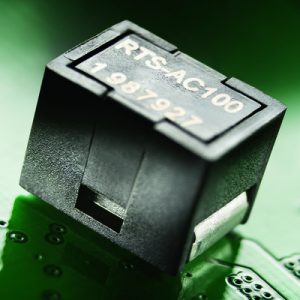
Rather than >210°C, they are rated at >175°C.
They have been developed to protect power semiconductors from over-heating – particularly from thermal-runaway when the semiconductors are in a confined space. In such an event, the thermal fuse interrupts the circuit, now from as early as 175°C.
- RTS-BC100 nominally breaks at 400A at 24Vdc, has a resistance of 90 – 110μΩ and operates over -40 to 125°C
- RTS-BS500 is similar, but has a resistance of 500 – 580μΩ because it includes a low temperature coefficient shunt Resistor for current sensing.
Footprint is 6.6 x 8.8mm (6.7mm high), even though they can “handle operating currents of up to 130A and voltages of up to 60Vdc”, said Schurter.
The devices need to be located adjacent to the Semiconductor they are protecting. Maximum nominal current depends on ambient temperature and on surrounding PCB tracks – there are derating curves in the data sheet. Two RTS devices can be paralleled to double maximum derating curve current.
| Variant | Trip temp |
Breaking capacity |
Shunt | Cold resistance |
Operation temp |
|---|---|---|---|---|---|
| RTS-AC100 | >210°C | 400A @ 24Vdc (L/R <0.3ms) 260A @ 52Vdc (L/R <0.2ms) 170A @ 60Vdc (L/R <0.1ms) |
90 – 110µΩ | -40 to 150°C | |
| RTS-AS500 | >210°C | 400A @ 24Vdc (L/R <0.3ms) 260A @ 52Vdc (L/R <0.2ms) 170A @ 60Vdc (L/R <0.1ms) |
Y | 500 – 580 | -40 to 150°C |
| RTS-BC100 | >175°C | 400A @ 24Vdc (L/R <0.3ms) | 90 – 110 | -40 to 125°C | |
| RTS-BS500 | >175°C | 400A @ 24Vdc (L/R <0.3ms) | Y | 500 – 580 | -40 to 125°C |